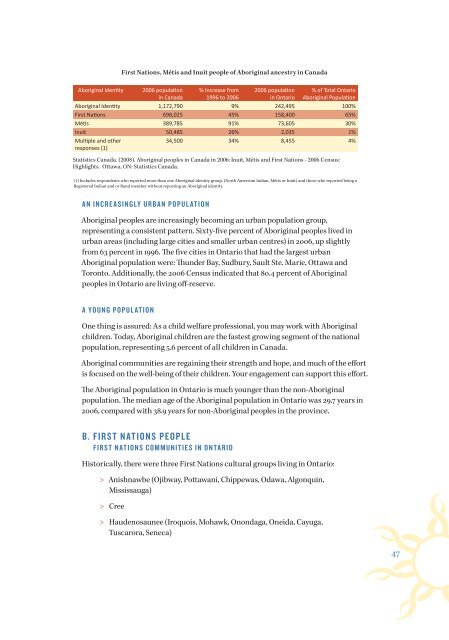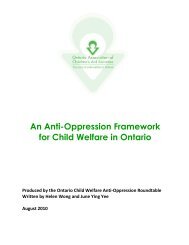English - Ontario Association of Children's Aid Societies
English - Ontario Association of Children's Aid Societies
English - Ontario Association of Children's Aid Societies
You also want an ePaper? Increase the reach of your titles
YUMPU automatically turns print PDFs into web optimized ePapers that Google loves.
First Nations, Métis and Inuit people <strong>of</strong> Aboriginal ancestry in Canada<br />
Aboriginal Identity<br />
2006 population<br />
in Canada<br />
% Increase from<br />
1996 to 2006<br />
2006 population<br />
in <strong>Ontario</strong><br />
% <strong>of</strong> Total <strong>Ontario</strong><br />
Aboriginal Population<br />
Aboriginal Identity 1,172,790 9% 242,495 100%<br />
First Nations 698,025 45% 158,400 65%<br />
Métis 389,785 91% 73,605 30%<br />
Inuit 50,485 26% 2,035 1%<br />
Multiple and other<br />
responses (1)<br />
34,500 34% 8,455 4%<br />
Statistics Canada. (2008). Aboriginal peoples in Canada in 2006: Inuit, Métis and First Nations - 2006 Census:<br />
Highlights. Ottawa, ON: Statistics Canada.<br />
(1) Includes respondents who reported more than one Aboriginal identity group, (North American Indian, Métis or Inuit) and those who reported being a<br />
Registered Indian and or Band member without reporting an Aboriginal identity.<br />
AN INCREASINGLY URBAN POPULATION<br />
Aboriginal peoples are increasingly becoming an urban population group,<br />
representing a consistent pattern. Sixty-five percent <strong>of</strong> Aboriginal peoples lived in<br />
urban areas (including large cities and smaller urban centres) in 2006, up slightly<br />
from 63 percent in 1996. The five cities in <strong>Ontario</strong> that had the largest urban<br />
Aboriginal population were: Thunder Bay, Sudbury, Sault Ste. Marie, Ottawa and<br />
Toronto. Additionally, the 2006 Census indicated that 80.4 percent <strong>of</strong> Aboriginal<br />
peoples in <strong>Ontario</strong> are living <strong>of</strong>f-reserve.<br />
A YOUNG POPULATION<br />
One thing is assured: As a child welfare pr<strong>of</strong>essional, you may work with Aboriginal<br />
children. Today, Aboriginal children are the fastest growing segment <strong>of</strong> the national<br />
population, representing 5.6 percent <strong>of</strong> all children in Canada.<br />
Aboriginal communities are regaining their strength and hope, and much <strong>of</strong> the effort<br />
is focused on the well-being <strong>of</strong> their children. Your engagement can support this effort.<br />
The Aboriginal population in <strong>Ontario</strong> is much younger than the non-Aboriginal<br />
population. The median age <strong>of</strong> the Aboriginal population in <strong>Ontario</strong> was 29.7 years in<br />
2006, compared with 38.9 years for non-Aboriginal peoples in the province.<br />
B. FIRST NATIONS PEOPLE<br />
FIRST NATIONS COMMUNITIES IN ONTARIO<br />
Historically, there were three First Nations cultural groups living in <strong>Ontario</strong>:<br />
> > Anishnawbe (Ojibway, Pottawani, Chippewas, Odawa, Algonquin,<br />
Mississauga)<br />
> > Cree<br />
> > Haudenosaunee (Iroquois, Mohawk, Onondaga, Oneida, Cayuga,<br />
Tuscarora, Seneca)<br />
47

















